Why Hypercard Had to Die
Update: Click here if you would like to try HyperCard yourself.

Hypercard (version 2.4.1.) "Home" card.
I was a Hypercard child - though our friendship was brief.
Our seventh-grade class was led into a room full of brand-new Macintosh Performas. The day's lesson was a crash course in the use of an uncomplicated yet marvelous program. With it, one might persuade a computer to do anything and everything - or so it seemed to a child with the attention span to appreciate the wonder. Half a dozen of us were invited back a week later; and then again, and again, for several delicious months.
Among these pupils, I was the only one who had already dabbled in programming. Compared to the familiar ROM BASIC of my family's second-hand Commodore 64, the HyperTalk language seemed clunky and comically verbose. And yet there was something magical, something oddly enthralling about Hypercard as a whole. The ease with which a mostly-blank screen could be turned into an interactive, living, breathing graphical toy of my own creation was astounding, exhilarating, and addictive.
After the final week, I and one other schoolboy were driven to a distant office building, where we were asked to present our unremarkable creations in front of a darkened lecture hall. The latter was full of somber-faced, suit-wearing adults idly tapping away on costly Apple portables. With their lukewarm applause, the adventure came to its rather boring end. Lacking true English fluency at the time, I never learned exactly who was behind this brief departure from the braindead routine of my early schooling. And without regular access to a Mac (given its expense, it may as well have been a Cray as far as my family was concerned) I could not return to this fascinating plaything. My development as a programmer continued as it had begun, almost entirely Mac-less and Hypercard-less.
Though almost unknown to the sniveling digital trendoids of today, HyperCard was and is one of the most loved software products ever created. It was quite possibly an inspiration for the World Wide Web. Among its satisfied users one could even find the rich and famous.
When Steve Jobs returned from exile to rule Apple again, he let HyperCard wither away and die. Why?
In order to answer this question, it is necessary to actually power up an old Mac (or an emulator) and try HyperCard on your own skin.
Even today, there is still a wealth of HyperCard-related material on the Net, but I was unable to find a compact "Hello World"-style walkthrough example. So I created one: a very basic "four function" calculator. The materials needed for this recipe were:
- Basilisk
- A copy of HyperCard
- (Optional) A HyperTalk manual. I fished mine out of a dumpster when I was an undergraduate student.
- Around half an hour of time. Most of it was spent arranging the screenshots and writing their captions.
Without further delay:
Create a new HyperCard stack:
Now give it a name and save it:
Now you have a fresh stack, with a blank card:
Create a field:
Double-click on it and give it the title "lcd":
Re-size the field to reasonable dimensions:
Create a button:
Double-click on it and then click on the Script button in the properties dialog:
Below is the HyperTalk script that we will attach to the numeric and operator keys of our calculator. It does only one thing: append the text of the button's name - be it a number or an operator - to the calculator's "screen." The name is going to be something like card button "5". So if we want to append the number five when the "5" key is pressed, we will need to take last whitespace-delimited word of the button name -- "5" -- and perform an "eval" on it, yielding the number 5. The "value of" operator is simply the HyperTalk equivalent of Eval.
Save the button's script:
We will give each button the appropriate name:
Copy the button as many times as needed to create the calculator's numeric keys. There is no need to change the buttons' scripts, only their names.
Create the operator keys in the same way:
Now, we will need an Equals key. Create a new button:
Give it the name "=":
Now, let's give it its script. We will need to use HyperTalk's Eval again:
Now let's actually try using the calculator. Switch to HyperCard's "finger" operation:
Now enter an arithmetic expression which makes use of all four arithmetic functions, and click the "equals" key:
The result will appear:
This is a quite useless calculator without a "Clear" key. Let's add one:
The script for the "Clear" key:
There is nothing surprising about what the "Clear" key does:
We now have a very simple four-function calculator.
Having seen what you just saw, do you now know why Steve Jobs killed HyperCard?
Well, you probably don't. And I don't either. Obviously the man is dead and will tell no tales. But perhaps we can figure out the "why."
Does anyone really believe that Mr. Jobs genuinely “thought you could do everything in Cocoa and ProjectBuilder that you could do with HyperCard” ? He was far too intelligent a man to believe any such thing. One may as well say that you could do everything with a magnetized needle and a steady hand that you could do with a text editor. Or that you could do anything with Roman numerals that you could do with Arabic numerals. Or that you could do anything in INTERCAL that you could do in Common Lisp. And so forth. Jobs was almost certainly familiar with HyperCard and its capabilities. And he killed it anyway. Wouldn't you love to know why?
Here's a clue: Apple never again brought to market anything resembling HyperCard.
Despite frequent calls to do so. Despite a more-or-less guaranteed and lively market.
And I will cautiously predict that it never will again.
The reason for this is that HyperCard is an echo of a different world. One where the distinction between the "use" and "programming" of a computer has been weakened and awaits near-total erasure. A world where the personal computer is a mind-amplifier, and not merely an expensive video telephone. A world in which Apple's walled garden aesthetic has no place.
What you may not know is that Steve Jobs killed far greater things than HyperCard. He was almost certainly behind the death of SK8. And the Lisp Machine version of the Newton. And we may never learn what else. And Mr. Jobs had a perfectly logical reason to prune the Apple tree thus. He returned the company to its original vision: the personal computer as a consumer appliance, a black box enforcing a very traditional relationship between the vendor and the purchaser.
Jobs supposedly claimed that he intended his personal computer to be a "bicycle for the mind." But what he really sold us was a (fairly comfortable) train for the mind. A train which goes only where rails have been laid down, like any train, and can travel elsewhere only after rivers of sweat pour forth from armies of laborers. (Preferably in Cupertino.)
The Apple of Steve Jobs needed HyperCard-like products like the Monsanto Company needs a $100 home genetic-engineering set.
The Apple of today, lacking Steve Jobs -- probably needs a stake through the heart.
Either way, expect no HyperCard (or work-alikes) from Apple. But how about other vendors? What about open-source projects? Nothing there, either. Oh, there is no shortage of attempts. And all of them are failures for the same reason: they insist on being more capable, more complexity-laden than HyperCard. And thus, none of them can readily substitute for it.
And if you think that XCode, Python, Processing, or the shit soup of HTML/Javascript/CSS are any kind of substitute for HyperCard, then read this post again. And if you continue to think so, then you might be an autistic typical software "engineer," and please don't waste your time commenting here. Sink back into the cube farm hellpit from whence you came.
Otherwise, sit down and contemplate the fact that what has been built once could probably be built again.
Corrections and Edits:
1. Steve Jobs did not kill the Lisp Machine version of the Newton, but did kill the entire Newton project.
2. All of the comments pointing out that HyperCard was already obsolete when Steve Jobs killed it are missing the point. Jobs deliberately killed its community by refusing to maintain the product or even release the source. He could have released the source to the welcoming hands of tens of thousands of enthusiasts. All of the modern HyperCard clones (all of them substantially more complex and therefore inferior to the original) do not add up to a HyperCard community. It is an elementary "tower of Babel" situation. "Critical mass" in user communities is a well-known phenomenon. I am sure that it was not unknown to Jobs. What he truly succeeded in killing was not so much the basic concept of HyperCard but the community.
3. The various HyperCard clones and HyperCard-influenced software lack HyperCard's radical simplicity and the resulting explorability. Explorability of the "master of all you survey" variety matters. All of the extra features in a more feature-rich system like SuperCard (or even VB) are not harmless. There is a fundamental difference, especially for a child, between a system which you can fully wrap your mind around and one with countless mystery knobs.
4. Everybody pushing Javascript, Python, Wx/Qt, Cocoa, and other abominations as "HyperCard replacements" simply does not remember being a child. And/or lacks a creative bone in his body. And/or is a malicious idiot.
May 2020 Update: Seems like many readers continue to miss the essential point, just as they did in 2011. Hypercard wasn't a gem of graphic design (1-bit colour, plain line graphics) or of programming language design (one of the many laughable attempts at "natural language programming") or of high-performance number crunching... but it was simple. I.e., the entire system was fully covered by ~100 pages of printed manual. It fit in one's head. (And did not take 20 years to fit-in-head, either, an intelligent child could become "master of all he surveys" in a week or two.) Where is the printed manual for the current MS VB, or the WWW's HTML/JS/CSS/etc stack (yes including all browser warts), or for any of the other proposed "replacements" ? How many trees would have to be killed to print such a manual, and would it fit in your house? Could you read it cover to cover, or would you die of old age first?

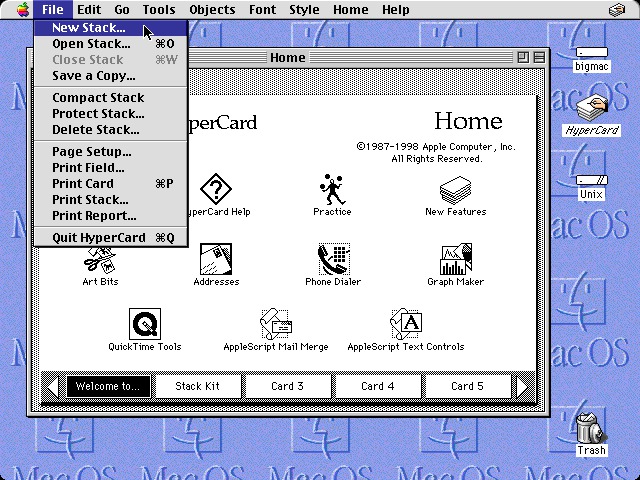
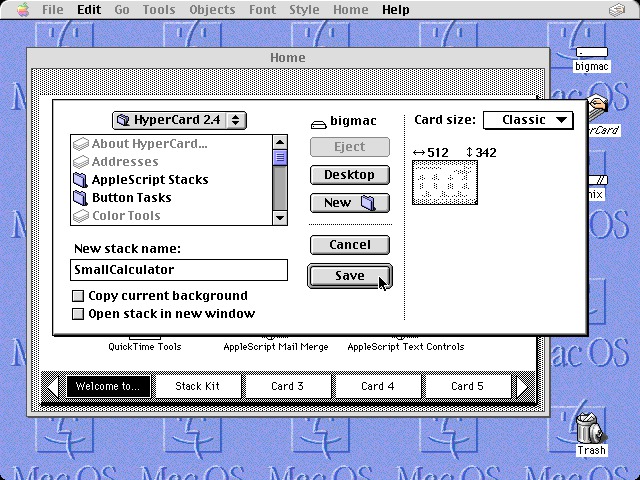

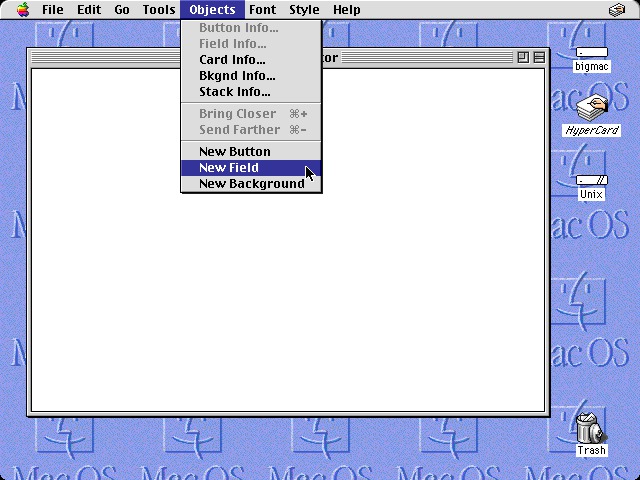
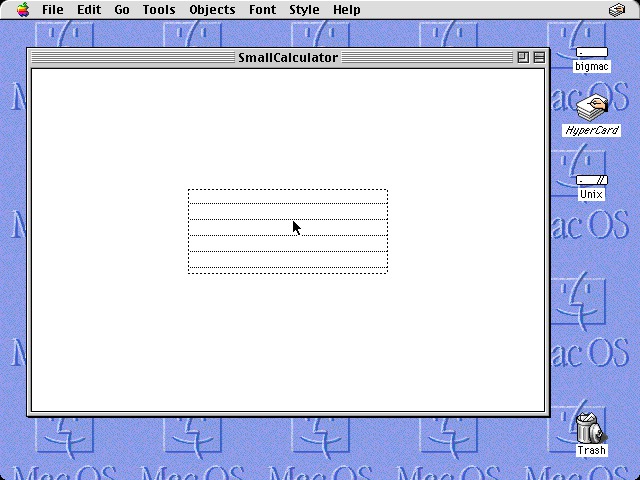
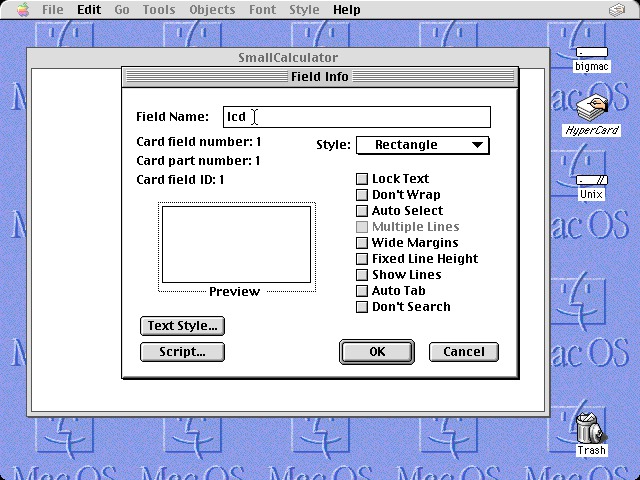
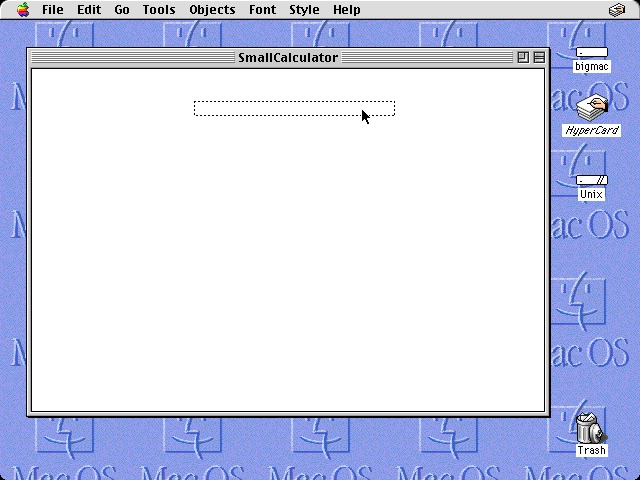
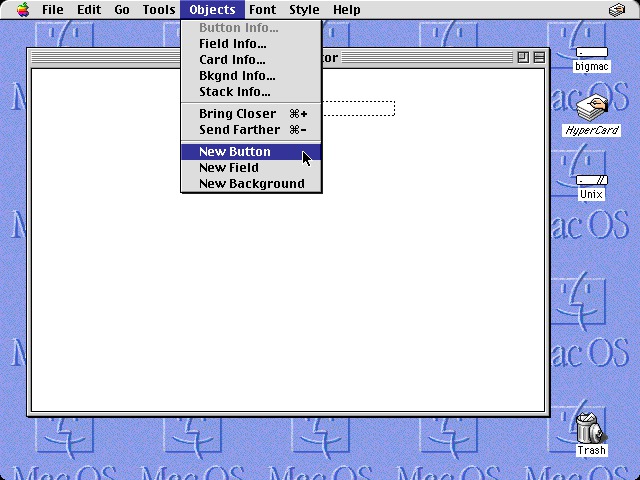
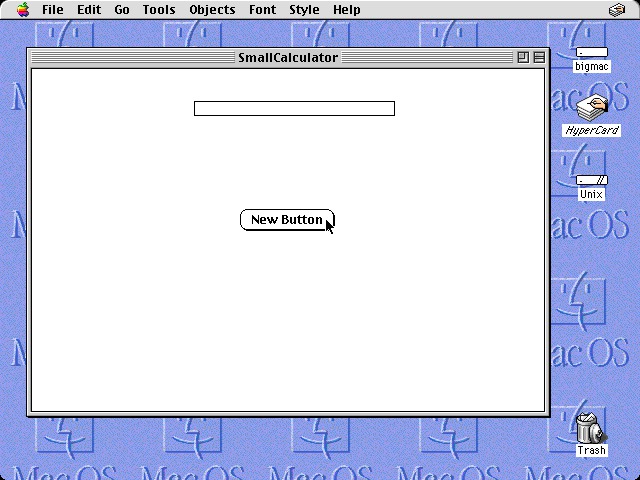
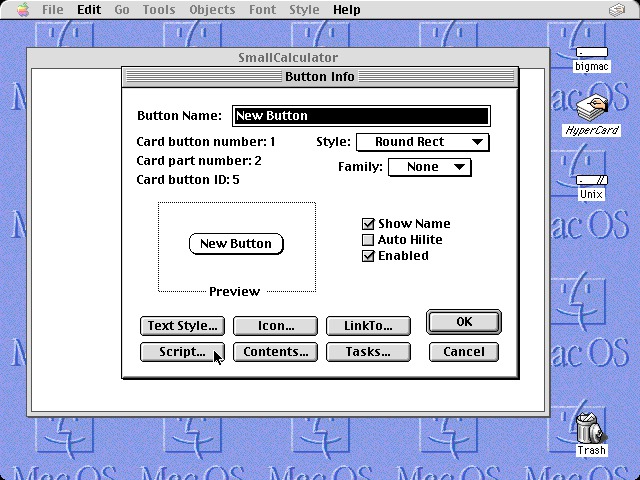
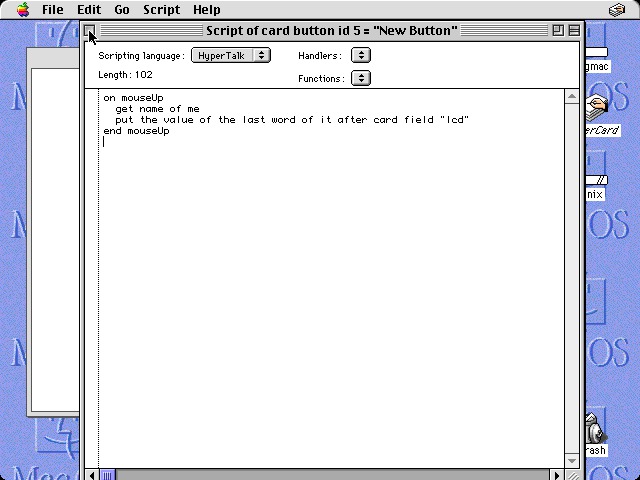
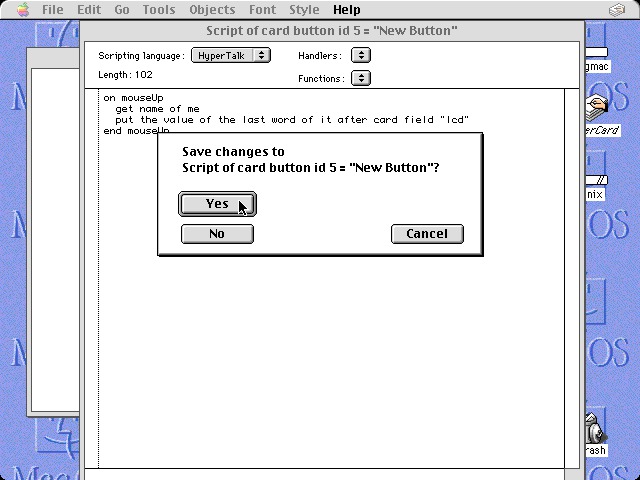
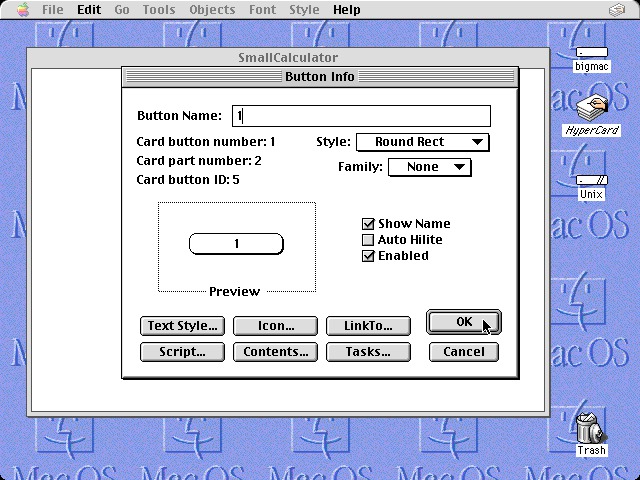
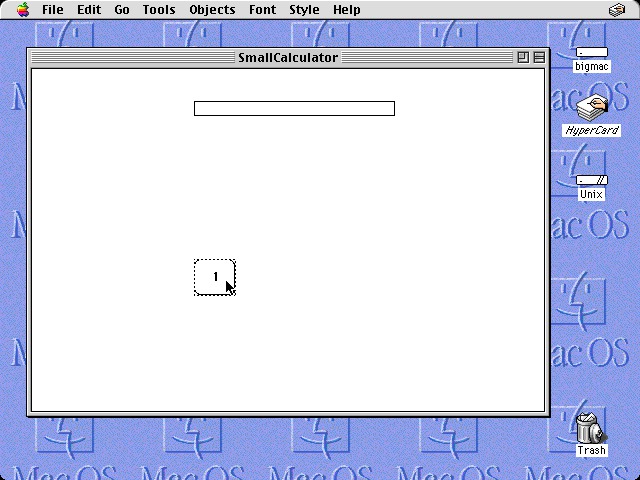
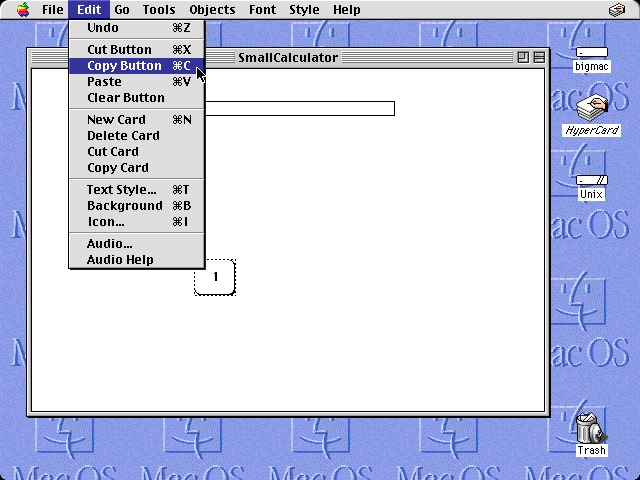
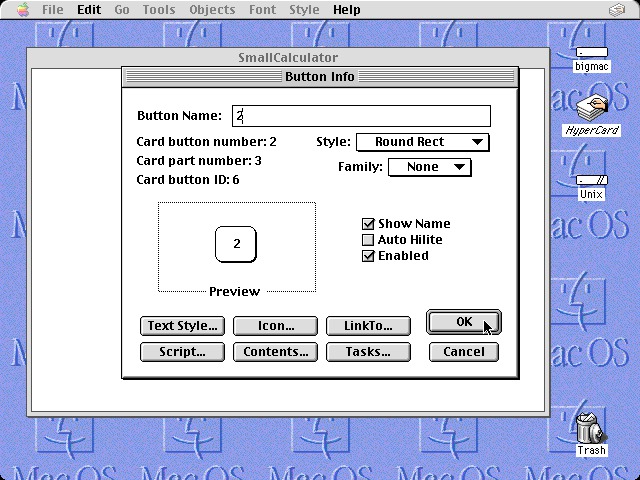
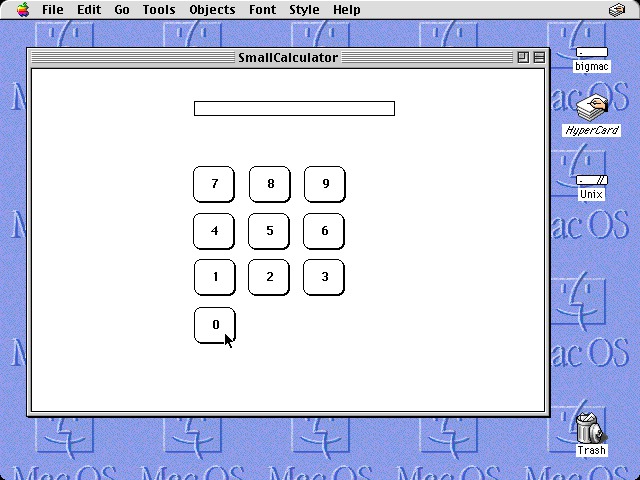
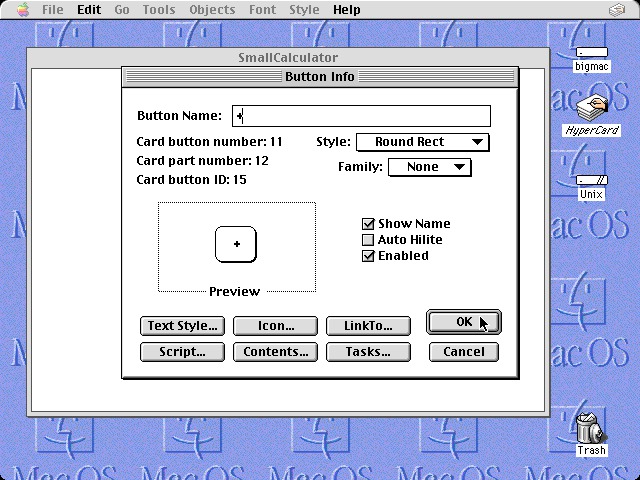
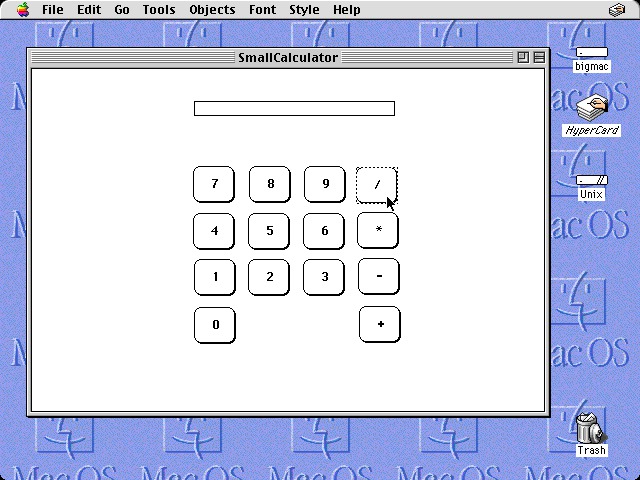
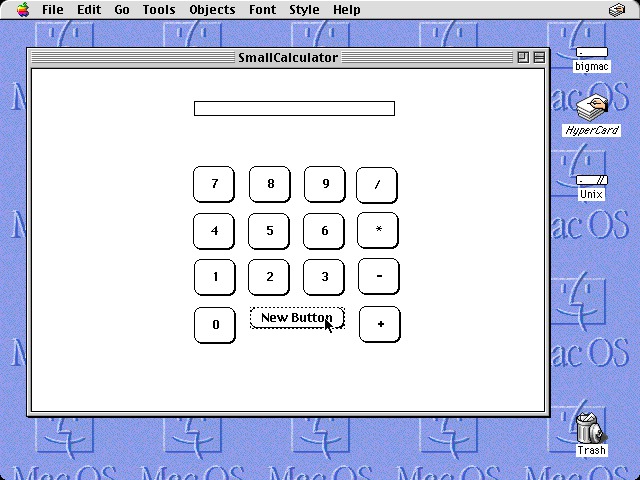
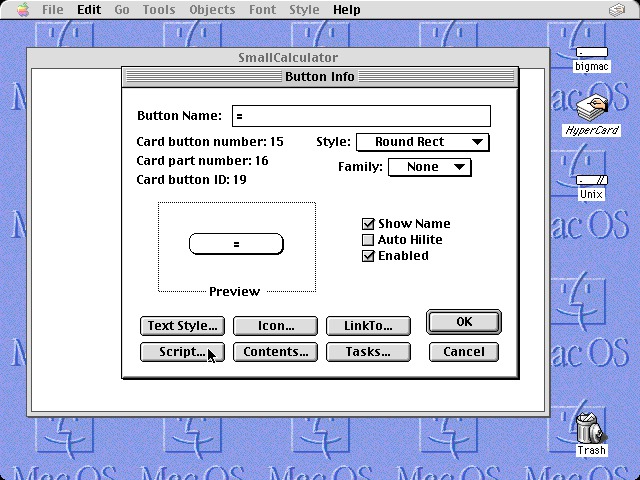
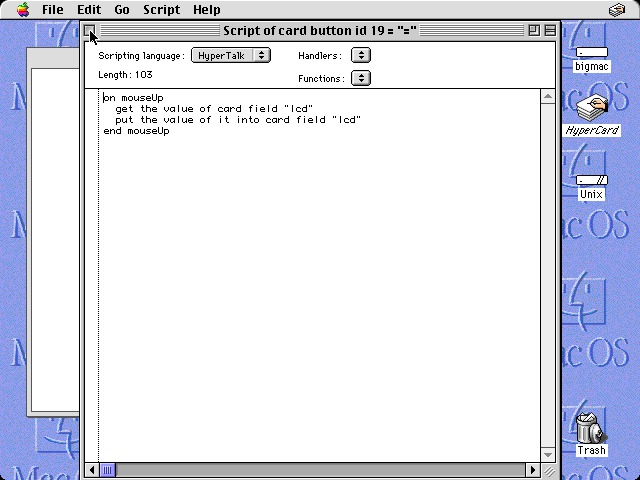
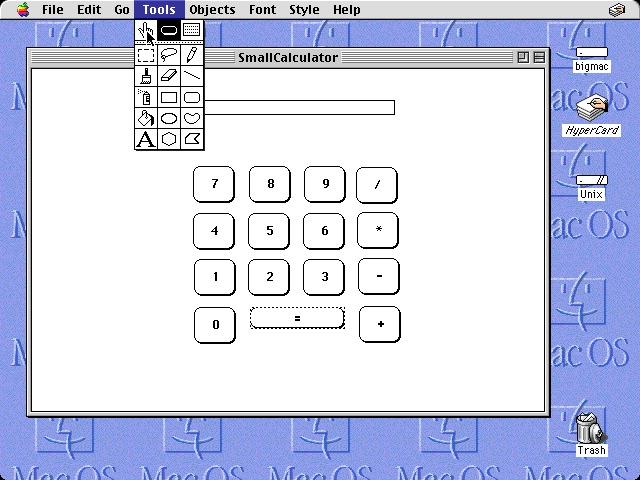
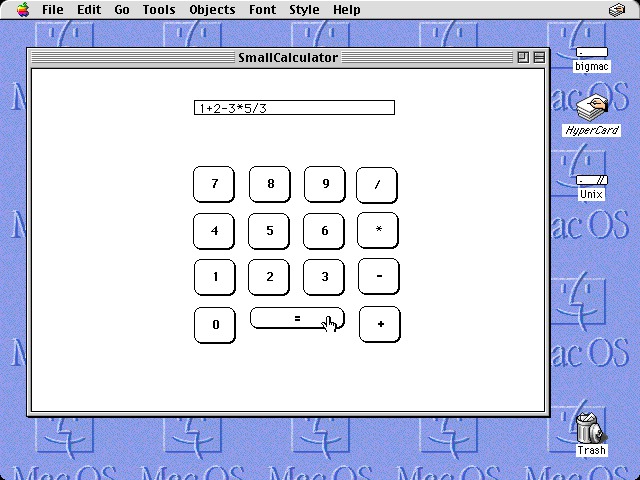
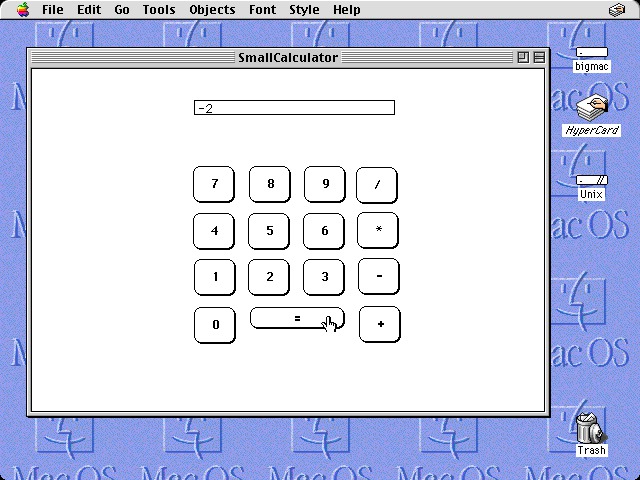
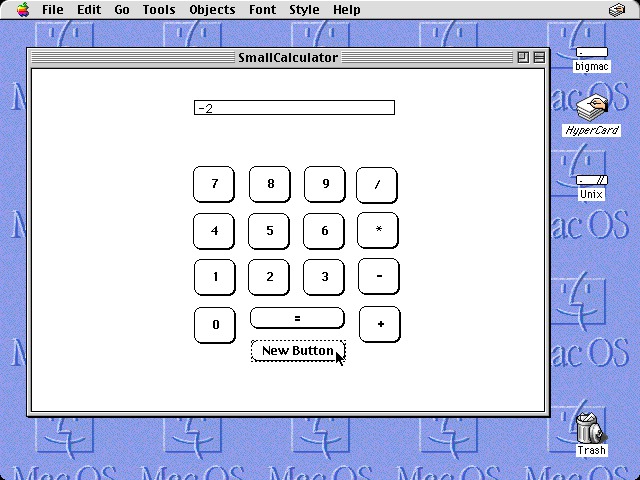
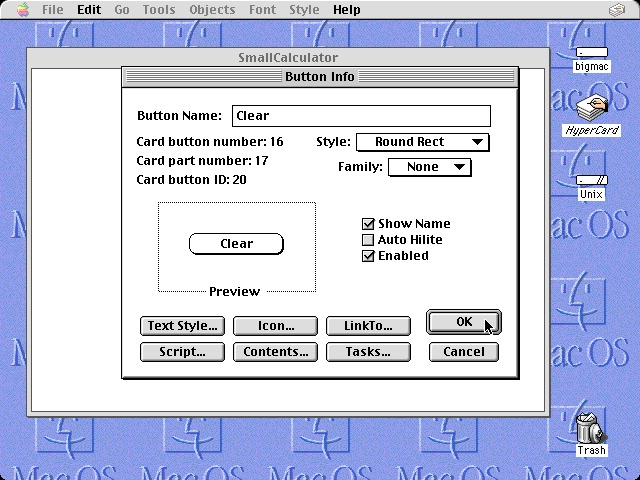
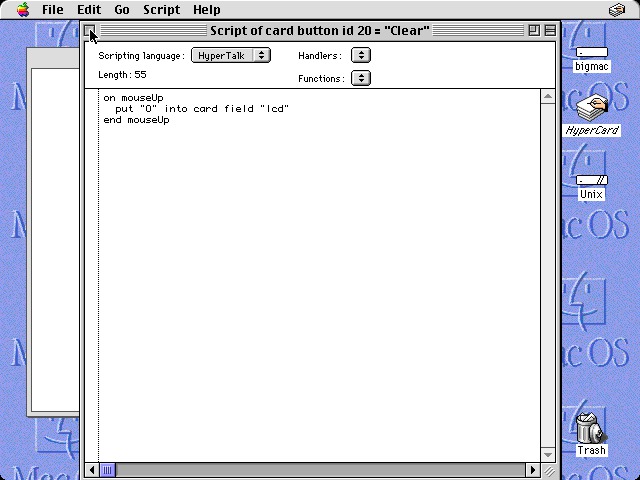
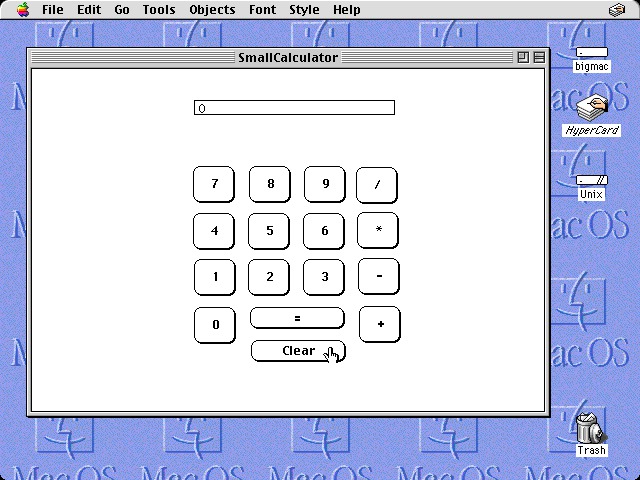


Good analysis. And we could say the same thing from the BASIC. Computer buyers are only consumers now. The only thing approaching this philosophy recently was Google App Inventor.
Sidenote: Bill Atkinson has attended a RunRev/LiveCode conference. I lost the link to where he says LiveCode is a worthy successor to HyperCard. He is on Twitter, but I don't dare ask him any questions. I assume he gets tired of talking about HyperCard. I'm also not interested in photography.
(For fanatics of software architectures: I recommend looking at Squeak and XanaduSpace. The concepts behind them are even more powerful than HyperCard.)
I loved Hypercard! Eventually I wanted more functionality and got a book that described XCMDs and XFCNs. At least that's what I remember them being called--extensions to Hypercard. That brought me up against "real programming," either C or Pascal, I can't remember which. It was too much for my 10 year old brain to handle without support and I ended up sticking to the well-worn paths. I remember some great stacks--great games, a handwriting recognition stack, a voice synthesis stack.
You're right, hypercard was a "different world." Great article.
Thankfully, in the multimedia domain we have a good selection of graphical programming environments at roughly the same level of abstraction and approachability as Hypercard that have remained quite successful over the past 15 years: Max/MSP/Jitter, Pure Data, and vvvv being the most popular. Thousands of digital artists with no programming experience use their computers, not quite as mind-amplification devices, but creativity-amplification devices, routinely. Ironically, one such environment is Apple's own Quartz Composer, but I would argue that it's a bit less approachable and has a steeper learning curve than the other environments I listed.
I was with you until the last paragraph. Where did that rant about "autistic" software engineers come from? I find the "aspy programmer" meme that's become popular pretty offensive; not least because it's completely misusing words for real conditions. Perhaps you could rethink the conclusion to your post?
you're right the programming interface of Hypercard doesn't have a successor today, but to my eyes the user interface and some of the concept did live on - as iOS.
Dear dylan,
How does iOS resemble Hypercard?
I am at a loss.
Yours,
-Stanislav
Welcome to the world of fanboism, where everything and everyone's decisions have to do with Big Red (or trying to "reach their level" or some such BS).
LOL
I've never had the privilege of being able to play around with Hypercard, but this article makes it sound a lot like Visual Studio (w/ Visual Basic) is today. I guess VS sort of fails in terms of portability (I wouldn't touch a Windows box for all the money in the world) and ease of use for absolute beginners, and VB fails completely as a language, so one could not call VS+VB a true successor.
"I wouldn’t touch a Windows box for all the money in the world" but "VB fails completely as a language, so one could not call VS+VB a true successor"? How can you say that if you've never used it?
As a professional programmer, the example above is strikingly similar to VB or VB.Net is clear to me. Apple never saw any benefit to providing a high level language to increase their developer base, where MSFT did. After watching Jobs closely, I believe he felt if you couldn't write a program in low level language, such as C or a C derivative like Obj-C, you had no business in programming, hence his slighting Hypercard. This was clear in Next and it's close cousin, IOS.
"html/javascript/css"=shitsoup? Um, why is the entire world using it then? You're more than welcome to invent something better. I'll wait. It works well for what it's for.
I've heard this argument over and over about Hypercard. Time to move on. The rest of the world has. If not,let's discuss VHS vs Betamax. It's a worthless discussion.
Let's do something more productive!
Dear Bill,
> How can you say that if you’ve never used it?
I used VB as a teenager. It is not a pleasant memory. All MS software has a certain very special flavor to it, which I don't like at all.
> “html/javascript/css”=shitsoup? Um, why is the entire world using it then? You’re more than welcome to invent something better.
Evolutionary local maximum. "Chicken and egg" problem. And so on. Surely you know this.
> Time to move on
To what? All I ask is that actual progress happen in computing, rather than mere movement.
Yours,
-Stanislav
> “html/javascript/css”=shitsoup? Um, why is the entire world using it then? You’re more than welcome to invent something better. I’ll wait. It works well for what it’s for.
It is pretty bad. You have at least 6 different implementations from six different companies with different capabilities and 6 different interpretations as to what each parameter means. Not to mention that each version of each browser has fixed "bugs" so you can't even assume one browser works consistently.
Add to that you have about 3 different codecs, a number of browsers which choose not to support plugins such as Flash or Java.
Add to that, HTML/CSS/JS was never meant to be a rich media language and was bolted on. As such, it's not as efficient / easy to make animations and whatnot.
Just because "the whole world's" using it (they're not, that's why Flash and Java exist) doesn't mean it's the best solution. It just means it wormed it's way up.
So you're writing an article about a piece of software the world has left behind. And you end by implying through the clever use of punctuation that typical software engineers are autistic. Don't shit where you eat...
Otherwise, interesting read. I fear it is too late to teach the unwashed masses programming though. Apple, Microsoft and Hollywood have put paid to that.
So not shipping HyperCard is partial grounds for driving "a stake through the heart of Apple," then you say that noone else has shipped an equivalent either. What melodrama!
Dear Douglas,
Apple needs a stake because: lacking Steve Jobs, it is a grotesque undead organism, blundering along though its head has been chopped off. Nothing to do with failure to resurrect Hypercard.
Yours,
-Stanislav
Didn't Steve Jobs kill HyperCard? If so, why is post-Jobs any worse than the Jobsian era?
i never saw hyper card. but your pics immediately brought this to my mind - **VISUAL BASIC** , good old VB.
HyperCard was what got me into programming in the first place. It stopped computers being a confusing mass of ones and zeros (after looking at POKE commands on the Commodore 64). I hope you include it in your operating system (which I am hoping to be able to use one day).
[...] of us were invited back a week later; and then again, and again, for several delicious months. Link – Trackbacks Posted in User experience (UX) | Permalink. ← Design Staff – Why you [...]
Great trip down memory lane!
HyperCard was simple but flexible. I wasn't much of a programmer when I was younger (even though I work as a video game programmer now!) but it allowed me to make all sorts of things with minimal programming. Adventure games (location for each card, invisible buttons over the top of doors etc linking the locations together) and animations (flip book page on each card) were my favourites.
The Viewpoint Research Institute gives us reason to hope, I think. I don't know how exactly their STEPS project took inspiration from Hypecard, but if they manage to fit a whole system in less than 20,000 lines of code, (their stated goal) It must be something reasonably simple.
VPRI's STEPS project is not inspired by Hypercard. It's inspired by the bloat and inflexibility of current computing systems. See: http://tele-task.de/archive/video/flash/14029/
I miss it.
I do completely agree. I was into HyperCard A LOT! I was even commercially successful with HyperCard. In this few years that we had HyperCard, ten thousands of incredible stacks came to live, from private persons, teachers, professors, bird watchers, butterfly collectors and I do not know whom. All these stacks were unique, personal, motivated by some private interest and expertise. This stacks were pretty much like Apps, but, as I would say "with a soul". The simple b/w design would just underscore this feeling of originality. You looked at the stack and you "saw" the author in it. The ten thousands polished iOS Apps we see today are simply crap, compared to what the HC community created.
HyperCard was a way to express yourself in Code, just as you can do in written text or photography for example. And it took not more effort to learn as to learn to handle a camera properly (or program your TV-set). HyperCard was not just a "free and easy" thing, by its nature it produced a complete new kind of media. And ten thousands of gems in that media are lost.
The who never used HyperCard, can not judge it. As you write, there is something special with that environment, that I cannot put into words, and this might also be the reason, why there is no successor. At least I do not really understand what made it such a special experience. It is not only about its availability or ease of access or simplicity of the language - there was a deeper, psychological aspect in it.
PS: I work with LiveCode and it is a suitable replacement of HyperCard. Of course it is blown up with all the new stuff like regexp, sockets, XML, multiplatform and so on, but you can use it just like Hypercard. It even comes with the bulky b/w icons. But it is really expensive and therefore never will become cult or build a large community.
I must disagree with one small point: the original Apple hit, the II series, is as far from the walled garden idea as possible. True it's a Wozniak design, but it is the quintessential hacker computer. This is the original Apple.
Yet, not everyone is inclined to be a programmer. Hypercard serves some people well, but most, and Apple has dropped "Computer" from its name long ago, just want, sadly, a black content-consumption, black-box.
um.. yes, apple releases and supports new versions of hypercard regularly. they're called WebKit and Safari.
Dear Max Cantor,
You might as well say:
"apple releases and supports new versions of hypercard regularly. they’re called Intel CPUs."
See my point about a magnetized needle and a steady hand.
Yours,
-Stanislav
I can't believe I'm reading this. It's SO exactly what I felt when Apple killed Hypercard. I never got over it! I could BUILD stuff in Hypercard.
You have a major mistake in your history. HyperCard died when Claris was brought back into Apple in 1991-92, this was before Steve Jobs returned.
-David Minor
(formerly) HyperCard Development Team
Dear David Minor,
Steve Jobs did fire the remaining developers in 1998. And pulled the product out of the Apple store in early 2000s. This is what I was referring to as the true, conclusive death of Hypercard. But I am aware of the fact that not much was happening re: official development after 1992. But did it really need to? Hypercard was unique in that most of the development carried out in it was truly in it - that is to say, by users. Arguably all that was needed from Apple's end was to allow it to be ported to modern architectures. This is what Jobs prevented.
Yours,
-Stanislav
I had forgotten about Claris. It was set up to commercialize some of the Apple developed apps. HyperCard was Free. Apple made no money on it other than people buying Apple Macs to use HyperCard. In the early 90s I worked at the University level and our educational software migrated from HyperCard to SuperCard because of its superior graphics. SuperCard was commercial software but it didn't succeed (or succeed that well).
My feeling is that it cost too much money to keep non money making applications like HyperCard. HyperCard had a devoted audience but it is small compared to other software that is used by everyone.
The entire history of personal computing has been an exercise in AVOIDING versatile computing power falling into the hands of the people.
Starting with IBM running several design teams to produce a 'PC', then choosing the most horrible, crippled, restrictive and effort-wasting result. Segmented architecture, bah. How many millions of programmer-hours did that waste? And little things - did you know the first design for the XT parallel card was bi-directional? But somebody made the designers take that out before market. Took years to get it back.
Objectives: 1. to slow down the evolution of small, cheap computers, to extend the capital returns on IBM's Big Iron as long as possible. 2. Keep versatile computing out of the hands of the people. It's ALL political.
Both Jobs and Gates were always agents of the Elites, running a fake 'competition' scam, to fool people into thinking there was a choice. Yeah, between salmon or perch flavoured cat poop.
"HTML/javascript/CSS shit soup" - yes, exactly. Explain to me why there isn't ONE unified textual presentation/processing/transmission extensible language?
We're going to have to do 'computing' all over again, from scratch, before we get it right. While shooting any corporate control freak, IPR-enforcing closed-computing platform bastard who tries to screw it up this time, again. You know that, don't you?
AppleScript, Automator and Quartz Composer look like absolutely legit tinker tools to me. I wouldn't be surprised if Apple killed off all of them, and they might never find a place on iOS. But I found the Mac to be much more open to casual development than Windows and Linux combined, and I've only started using it with 10.4.
[...] http://www.loper-os.org/?p=568 [...]
I never did get to play with Hyper Card for more than a few hours as a kid, it certainly felt magical at the time.
Looking at your tutorial though, I think there are a few similar options available today. I'm saying I think there are similar options because, I am not 100% confident in my memory about these thing (being autistic and all!).
Qt?
VB?
WxWidgets?
That Tool from Sencha?
FileMaker?
That smalltalk based visual IDE meant for kids that the OLPC project pushed?
Do you have experience with any of those? If so, what do you feel are crucial differences in comparison to Hyper Card?
--
Dennis
Dear Dennis Harrison,
> Qt? WxWidgets?
Both vomit-inducing. It was a prolonged struggle with Qt and then WxWidgets which led me to where I am now: hating the entire C/C++ ecosystem, as something fundamentally evil.
> VB?
Please see my earlier comment re: VB.
> FileMaker?
I have not used it, but from the manufacturer's description it doesn't strike me as Hypercard-like - no more so than MS Excel is.
> That Tool from Sencha?
The web stack is shit soup. Anything built on top of it inherits the flavor. At least for so long as MS IE exists in any form.
> That smalltalk based visual IDE
Squeak? "Like being drowned in Skittles." But actually a fairly good example of Seven Laws-compliant computing.
Yours,
-Stanislav
About Filemaker: it's nothing like either Excel or Access. It's a database, it's scriptable, it's endlessly adaptable and is enormously popular. Might be interesting to try building that calculator in it - I bet it would work. Oh - and Apple owns FileMaker, yet this product is wide-open to add-ons, custom functions and you name it. Absolutely the opposite of a walled-garden. It amuses me no end, too, that a Filemaker solution I built in 1991 to run on a Mac SE has been adapted, expanded, colorized, etc. and now can be run on / accessed from any PPC or Intel Mac, any decent PC plus iPhone, iPad and over the web - simultaneously. Don't go driving any stakes anytime soon, OK? I can do without Lion in a big way however I'll be patient and wait for what comes after it, then will upgrade.
I can't help but expand on your rant:
IMHO Flash versions <= 5 was the closest a mainstream product came to reproducing the utility and fun of Hypercard. It was quite successful in delivering the creative power of the computer to novices and amateurs as well as some seasoned pros. Even if it's power was abused on the web ( splash animations, over-use ), Flash also brought us many very interesting artistic creations ( Joshua Davis ). The heart of Flash slowed and then stopped when Adobe bought Macromedia and turned Actionscript into Java. There's nothing wrong with AS 2.0 and AS 3.0 per-se or Java for that matter either. However, when it comes to delivering computing power to novices, they were a failure in comparison to Flash w/ Actionscript 1.0.
Also, what happened to Legos? They used to require a child's creativity to come alive. Now the pieces are prepared perfectly for fewer configurations allowing for limited creativity.
However, all is not gloom and doom. Today we have Arduino and tons of other cool things going on. That's cool!
I miss HyperCard too and it's shocking that it hasn't been brought back at least for iOS.
And programmers, let me interpret his insult because I understand the sentiment behind it (and sometimes engage in it too out of similar frustration): You guys are all experts in your field and sometimes fail to see the beauty in simple training wheel solutions such as HyperCard. It gave a measure of control back to users without requiring the innate mental ability and expensive schooling most of you possess. At the very least, it was *fun*. And who can really argue against something that allows users to *create* run rather than being forced to *buy* fun?
This attempt at explaining the demise of hyperCard does not convince me because it does not consider major facts.
For example, off the top of my head:
1. Steve Jobs did not kill HyperCard. There had been no HyperCard development to speak of all throughout the 1990s. So HyperCard was already significantly behind the times when Jobs returned. At most, you can accuse him of not resurrecting it.
2. When Jobs returned, Apple was not very far from bankrupt. In order to turn the company around, he jettisoned many, many products, including the well-regarded LaserWrite line (which hasn’t returned either). This pruning allowed him to focus the available resources on the really important stuff. Really important stuff, at the time, meant above all the core OS, so there were hardly developer resources to spare for peripheral software products.
So, overall: Nice attempt to retrofit history to a particular worldview, but unconvincing in my eyes.
-h
Dear Hugo,
> Steve Jobs did not kill HyperCard.
Please read my earlier comment re: Steve Jobs killing Hypercard.
> he jettisoned many, many products, including the well-regarded LaserWriter line
Was there a petition with thousands of signatures begging Jobs to sell LaserWriters at any price, like there was for Hypercard?
Yours,
-Stanislav
I don't understand your point.
OK, Apple kill and did not replace the HyperCard app. Right. Like it did with numerous software when it felt that other editors could feel the void or if having such a software was mandatory for the Mac platform.
The Mac is an open platform. Anyone can write and distribute a Hypercard knockoff.
However, such an app would not be accepted by Apple on its AppStores (iOS/Mac) because that would mean adding feature that were not reviewed by Apple (for quality, content or commercial reasons).
So, Mac OSX being an open platform for anyone to provide such a tool, your argument is moot.
PS: I think I've heard something about an approved app for iPad where you can develop locally but can not import or export "scripts" from external sources. It was based on an approved engine used for games. I can't find any link. I'll try to add a new comment if/when I find something.
The App you're thinking of might be Codif, which uses Lua. http://bit.ly/sBdiYR
Codify uses a fixed library of images and sounds and does not allow export or sharing of completed projects.
Dear OlivierL,
> So, Mac OSX being an open platform for anyone to provide such a tool, your argument is moot.
Anyone could - but no one did. Why is that? I probably should have said more regarding the fundamentally misguided modern Hypercard clones. The gist of it is that they insist on being more feature-encrusted. And thus end up losing the most appealing attribute of the original: radical simplicity.
You should also remember that, when Jobs killed Hypercard, he didn't simply end a software project. He dispersed the Hypercard community to the four winds. A resurrected Hypercard today may or may not amass such a vibrant community. The users of the original Hypercard did not get to teach a younger generation who could continue to use it. When you disrupt the social continuity of something, it tends to die.
Yours,
-Stanislav
> However, such an app would not be accepted by Apple on its AppStores
Do you mean like BayCard, which is listed on the App Store?
I love watching people invent things to get angry about.
What about SuperCard runs even under Lion:
http://www.supercard.us/
Dear NotTellinYou,
SuperCard is substantially more complex than Hypercard. This is the fundamental mistake made by every Hypercard clone known to me.
Yours,
-Stanislav
You are so correct about the "train for the mind." Communists love trains. HyperCard allowed the common individual the freedom to use the full power of the computer...the power to simulate their own world. Environments like Squeak's eToys (Smalltalk) and Scratch were rejected by Apple's App police because they have interpreters at their heart...interpreters that open up this "different world" to everyone.
Dear Mark,
I love trains. But bicycles have a place in the world.
Yours,
-Stanislav
I'm just repeating what many have said - Hypercard was long dead before Steve Jobs returned to Apple. Many of us wondered why it continued to be sold up until 2000. It was totally weird, as the last update for it was at least 6 years prior to its death.
Developing apps for the Newton was pretty similar to developing stacks for Hypercard. There was additional complexity available but the simple stuff was simple; they got the base case right.
Newton Toolkit never caught on to the same degree because you needed to pay Apple ~$600 for the software, not to mention you needed to buy a Newton. But once you had NTK and a Newton and had written an App, you could share it with other people by "beaming" it to other newton users, or just post it on your website or email it around.
Newton development was "fun" in much the same way that Hypercard was; iOS development is a HUGE step backwards in that regard.
Apple hates it when developers are creative. They cater to all other creative types, but to turn an artist into a software creator is verboten.
That is hypocrisy.
I had the good fortune to meet Bill Atkinson at an event where my iPad app was being featured. When introduced to him, I said "Wait a minute, the Bill Atkison? From HyperCard?" He looked surprised. I said "I learned how to program using HyperCard. Thank you." He shook my hand, yelled at his wife "Hey honey, this guy learned to program with HyperCard!" then demo-ed his photography-greeting card app to me. Very nice guy.
Having worked at Apple when Steve returned I can tell you how products were evaluated. Steve met with the project heads and they had to convince him that their products were worthwhile.
Quicktime and AppleScript did this not because Steve had any, at least initially, deep understanding of the products but because the project heads could articulate why these were worth keeping. As pointed out earlier, Hypercard was dead years before Steve returned. There was no one left to argue for Hypercard. You had to be out of your mind to try to champion a product that had been dead for years.
The hypercard system was a pre-cursor to HTML.
It was the development of HTML that more or less killed hypercard. Also hypercard required some skill to make it work, where as the skills for HTML were driven by a GUI environment and thus made it preferable to a system where the user had to "program" it..
I use FileMaker as a hypercard replacement.
I agree with your assessment, especially when you factor in the death of OpenDoc.
In many ways this "compound document" architecture was an even lighter weight version of HyperCard that could produce even more powerful solutions with LESS programming. The first "mac only" browser, CyberDog, was created using OpenDoc.
Anyone comparing HTML and other systems (I believe RealBasic is the only thing that came even remotely close) to HyperCard never USED HyperCard, especially stack creation. Why draw a link when you could "tell" the button to send a message? The stack receives the message, and acts on, modifies, or passes it along. It was object orientated programming WITHOUT THE PAIN, all nicely wrapped up in a simple UI.
And it was extensible using XCMD's and such, as mentioned. Flash, ironically enough, got it's start by adding color (HC never broke out of it's one-bit ghetto) and other functionality to HC.
If someone came up with an open source replacement to HyperCard (especially if it allowed you to play/convert HC stacks) I would be all over it!
Realbasic does a very good job replicating a "future" BASIC on multiple platforms. But the real heir to Hypercard is LiveCode. You have the language, plus cross platform - even now to iOS.
> In many ways this “compound document” architecture was
> an even lighter weight version of HyperCard that could
> produce even more powerful solutions with LESS
> programming.
LOLZ. I suspect you never actually used OpenDoc in an effort to produce actual work. Or alternately, your definition of "light weight" is very different than mine.
On my fast development machine, the 7600 IIRC, opening a text file in OD took about 15 to 20 seconds before it because useable. The file, when saved, could no longer be edited as text. The system used megabytes of memory when open, files were enormous, and in spite of this the idea that one might be able to open any document anywhere was utterly untrue.
> The first “mac only” browser, CyberDog, was created using OpenDoc.
CyberDog was, as the name implied, a dog. It was considerably slower than other browsers, used much more memory, quickly grew outdated, and offered no features any other browser didn't. Yes, you could embed a browser page in a "text" document (see above for the reason for the quotes), but it utterly escaped me why anyone would want to do this.
OpenDoc was a big, slow memory hog that crashed all the time and offered practically no new features. Everyone knew it, and that's why it died. The only mystery is why it lived long enough to see a release, given how bad that release was.
You know, it was software "engineers" (your condescending quote marks, not mine) who built HyperCard. HyperCard was a great system but there is no magic fairy dust ingredient that prevents someone from building effectively the same thing today. Apparently there are droves of people who want it, yet somehow we are led to believe that only Apple can build it. Bullocks.
Dear Duane GRan,
> You know, it was software “engineers” ... who built HyperCard.
Nope. It was creative programmers (mostly one) who built it. There is a difference.
And my point was precisely that Apple cannot (or rather, will not) build it. And that Steve Jobs had a very logical reason for killing the original.
Yours,
-Stanislav
I completely agree with Stanislaws' analysis of Jobs behavior and conclusions and I wouldn't for a moment believe it was his meaning to be offensive to people who suffer from autism. Ingar
This entire article is hogwash, written by someone who admits to not having been involved with the project at the time (in school no less) but nevertheless goes on for paragraph after paragraph of complete supposition to produce a conspiracy theory that simply isn't supported by the historical record.
I was one of the beta testers for HC2.0, which was a limited group when we joined, and then watched in horror in the immediate aftermath of the project when the entire group just disappeared from public view, *poof*. We knew HC3 was coming, but any attempt to get in the development loop was impossible.
It wasn't until 1996 that we again saw it, but by this time it had been completely re-purposed as a multimedia plugin for QuickTime. I suppose this was an effort to cash in on the popularity of tools like Creator and such, but the problem was that Apple had no less than three such teams that *I* knew of working on the same thing -- HyperCard/QuickTime, the original Cocoa, and Kaleida Labs/ScriptX, and that's if you exclude the team that was writing a VisualBasic clone or Apple Media Tool!
This was extremely typical of Apple at the time, as there was basically no upper management direction whatsoever and middle managers were rapidly building empires around every ridiculous technology that the computer magazines thought was the next big thing. Does everyone forget Apple's telephony system? X.400 server? DAL?
As I recall it, Kevin Calhoun's demo at WWDC'96 was one of a number shown around that time, at which point HC once again went black. The fact that the project was officially cancelled years later simply makes official what appears to have been
So instead of conspiracy theories involving Jobs, the real question is how it is that Apple was unable to ship a major upgrade in almost a decade, half of that before Jobs was in control. Of course one can ask that of *any* Apple project of the era, notably Copland.
Dear Maury Markowitz,
> It wasn’t until 1996 that we again saw it, but by this time it had been completely re-purposed as a multimedia plugin for QuickTime.
Sounds like death-by-controlled-chaos to me. Just possibly.
At any rate, if Jobs did not in fact kill it, and it died a natural death, he simply got lucky. From his point of view as I see it, Hypercard had to die. Apple as we know it is incompatible with the Hypercard way of doing things.
Yours,
-Stanislav
Stanislav,
When I followed the link to your site, I was prepared to disagree as I usually do with most who dig up the dead - until I read your points. You are exactly right. SJ on his return made it no mystery that he wanted Apple to be a consumer products company. He said so many times when he was pitching his "digital hub" at MacWorlds. End users building simple apps prolongs the life and use of consumer products that he'd much rather see you replace with a new product sporting a handful of new apps and modest improvements.
Fortunately those who still subscribe to the 'card way do have (more complex, but also more powerful) solutions, such as LiveCode.
VB has changed a lot since the 90s. It's not the same language, it's evolved for the better.
I use php and PostgreSQL to do what I used to do with HyperCard...jQuery mobile could be extended to produce a HyperCard like environment...
Sorry, Lynn, LiveCode can in no way replace HyperCard. Some of us who use HyperCard are not "end users building simple apps" to make you b u y them, we are out to solve real, fundamental problems of the real world, and HyperCard is a real problem-solving tool, while LiveCode has been reduced to an app-construction tool-kit. For example, to construct Civana, the anti-statistical, Civistic tool that I have developed and presented at the Nordic Congress of Sociology this year, I had to use HyperCard and a PowerMac G3. There is still a lot to be done, but it works.You know, the world is not an app-market. Here is the link: http://iro.on-rev.com/Statistical_masking.htm. Ingar
I am probably a programmer today because HyperCard made it easy for me to teach myself the basic concepts at an early age.
These days, when I want to rapidly make a GUI application I tend to use Visual C++. But my nostalgia for the days of HyperCard has made me consider buying LiveCode on more than one occasion.
Raptor, it would have been interesting to get your comments after trying to "rapidly make a GUI application" in LiveCode and comparing it to doing it in HyperCard. The pioneer of object oriented programming was Kristen Nygaard, together with Ole-Johan Dahl. They developed SIMULA I (1961–1965) and SIMULA-67 - the first object-oriented programming languages, introducing the concepts upon which all later object-oriented programming languages are built: objects, classes, inheritance, virtual quantities and multi-threaded (quasi-parallel) program execution. In 2004, AITO established an annual prize in the name of Ole-Johan Dahl and Kristen Nygaard to honor their pioneering work on object-orientation. This is relevant as an assessment of the excellence of HyperCard because Nygaard was crystal clear on the following point: Nothing matches HyperCard when it comes to fast and efficient prototyping. Ingar
Alan Kay is still at it: http://www.vpri.org/pdf/tr2011004_steps11.pdf
[...] OS provides an interesting analysis of why hypercard was discontinued. He acknowledges that hypercard was possibly the most loved software products of all [...]
"shit soup of HTML/Javascript/CSS"
Alas sir, you are too kind.